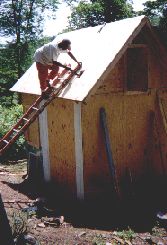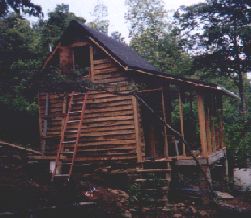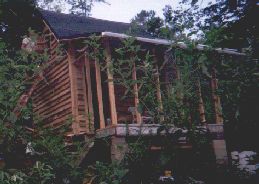Development - Larger Huts
Your average piece of plywood is 4 feet by 8 feet; your average stud is no longer than 8 feet; and your average pickup truck bed is no longer than 8 feet. Given this, it's not strange that our largest panels are 8' x 8'; once you start getting larger, getting the materials and finished panels transported and assembled becomes much more difficult.
However, for several years the Housers did experiment with larger structures. Led by Frank Jeffers, we put together a test 8' x 8' and then created several 10' x 10' cabins in conjunction with local organic farmers. Ultimately, given the additional expense and difficulty of these larger structures, we decided not to pursue them for our mission with the homeless.
Here's a photo essay of one such build.

Joe Agana does some work on the roof. The hole he's fiddling with is where the flashing will be attached so the stovepipe has a place to exit the structure. The roof pitch of the cabin is higher than that of a hut, so we had to be extra careful.
The cabin has the same basic manufacturing method as the hut: prefabricate the panels, bring them to the site, and assembled them there. On the wall, the size difference mainly meant inconvenience; but for the roof, floor, and loft, it meant a redesign. The roof can no longer be made from single sheets of plywood, and so became panels in their own right - much heavier and more unwieldy. Similarly, the floor was pretty much impossible to transport by itself, and so was cleverly designed to be transported in two pieces and reassembled with ad\ ditional bracing.

The front of the framed cabin, showing the tarpaper up on the roof and the front porch.

The clapboard goes on. Clapboard is not the usual option, and it was a bear to install. However, the sponsors had plenty of it around. Looks nice, doesn't it?

Rear of the hut. Note the small window, currently closed. The window is situated catty-corner from the front door. That way, when opened, it not only provides additional light, but a\ ir can flow across the whole cabin.

Front of the cabin after the clapboard has been attached. You clearly see that the cabin, like other Mad Houser structures, is resting on supports so that it doesn't touch the ground. In this case, since it's resting on a hill, the front is higher off the ground than the back.
By raising the structure off the ground, we both help keep it level and keep the bottom from rotting out through contact with the damp, insect-laden ground.

Although much larger than a hut, the cabin is still heatable with one of our stoves. The shiny metal behind the stove reflects heat away from the wall back into the structure, both protecting the wall and conserving heat. This can also be done with a pile of bricks stacked behind the stove.
The stovepipe runs through the opening in the loft level where the steps will be installed. You can see some boards nailed to the inside studs which are temporarily acting as a ladder to the loft.
